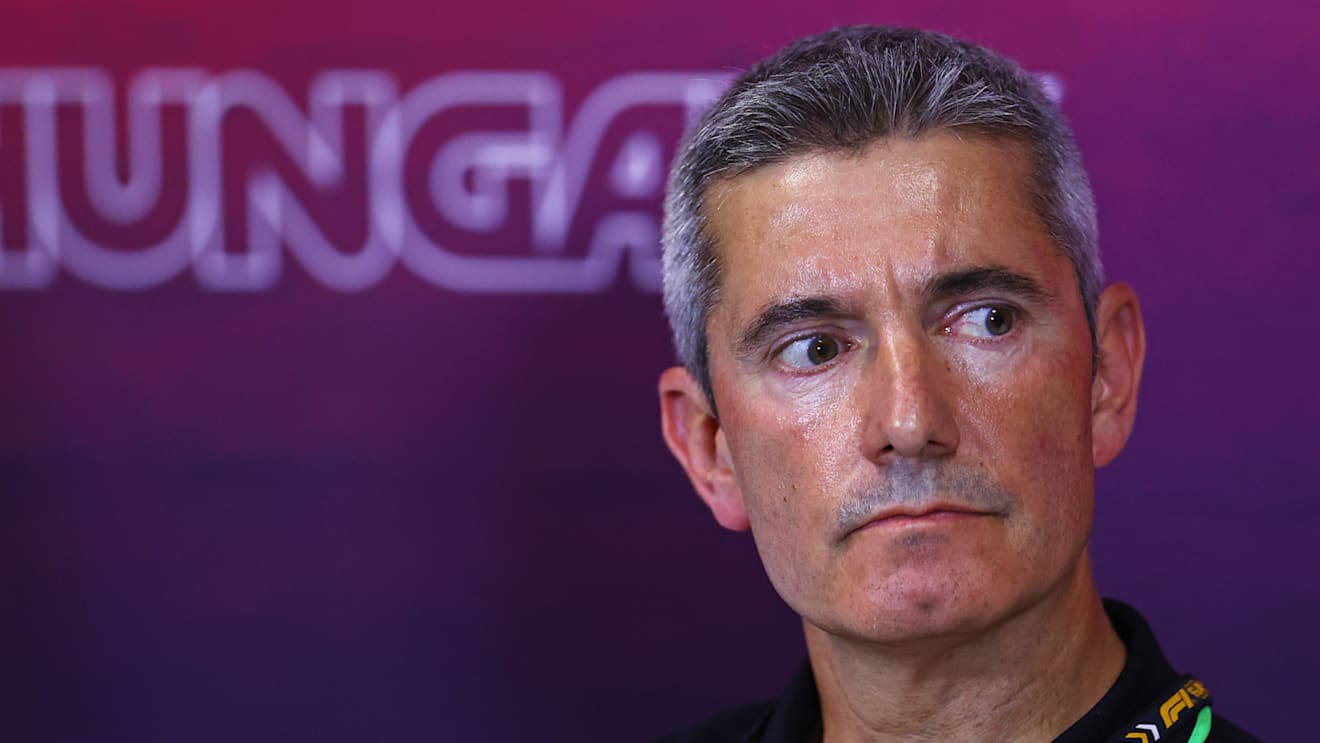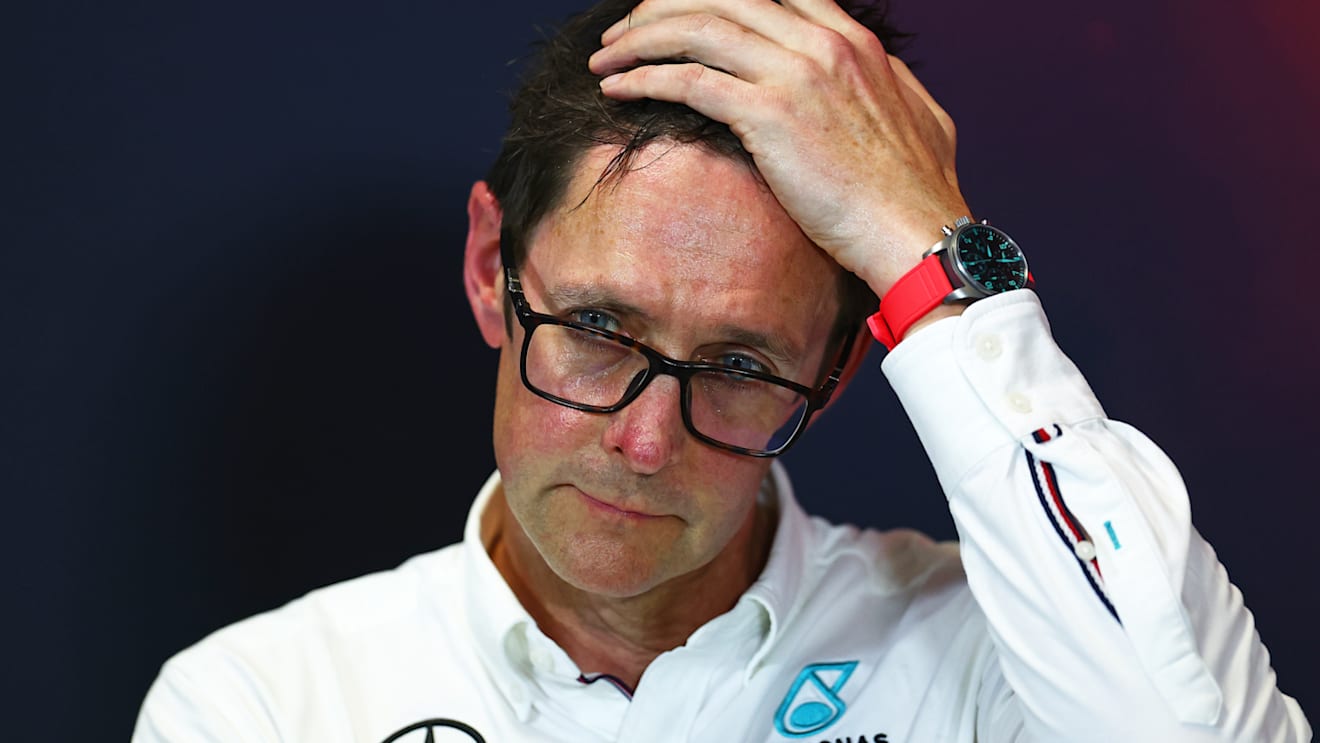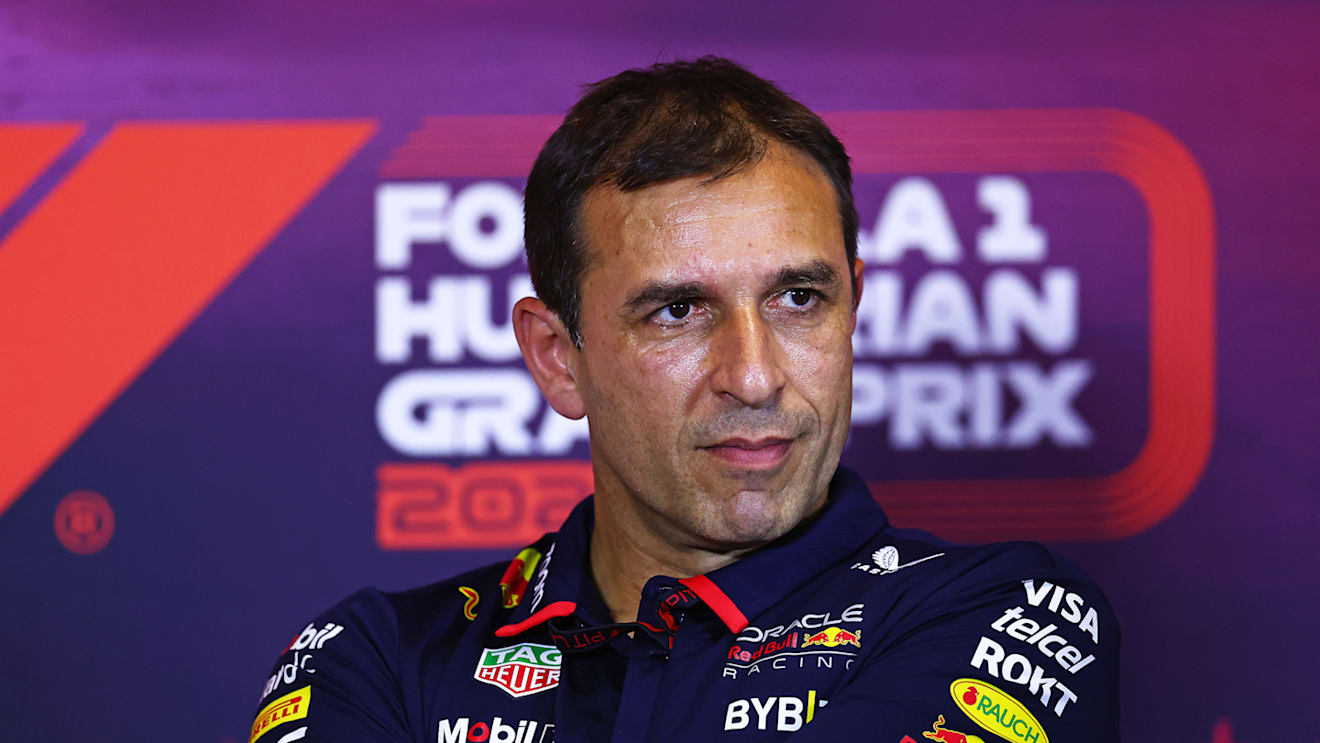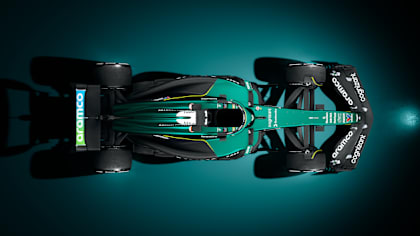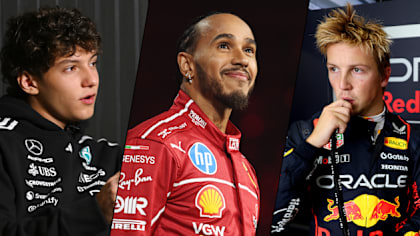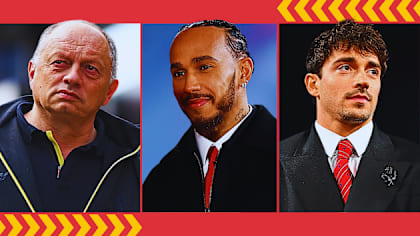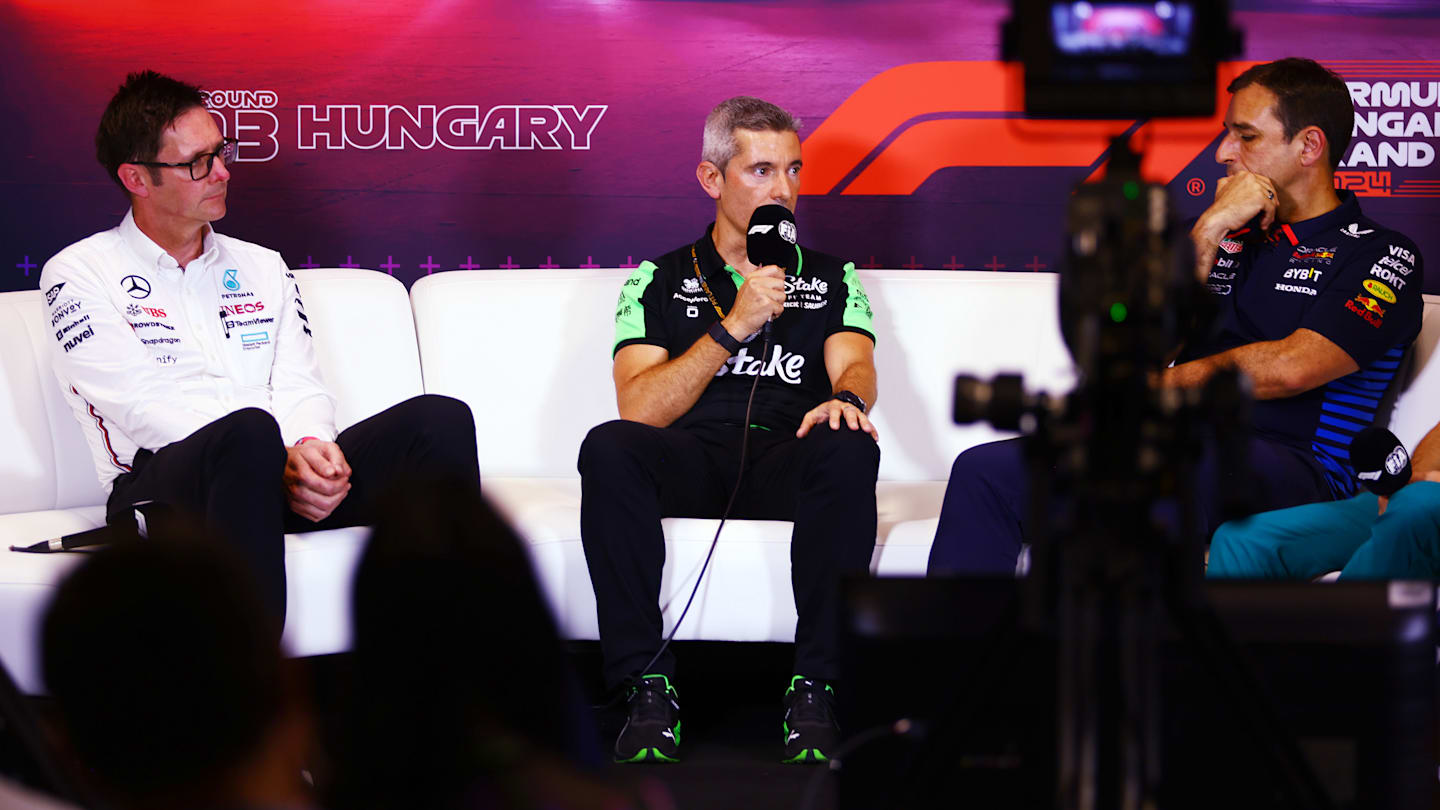
News
FIA Team Principals press conference – Hungary
Share

TEAM REPRESENTATIVES: Andrew SHOVLIN (Mercedes), Xevi PUJOLAR (Kick Sauber), Pierre WACHÉ (Red Bull Racing), Dan FALLOWS (Aston Martin)
Q: Dan, with you, if we could. You've just been back-to-backing old parts with new parts in FP1. What did you learn?
Dan FALLOWS: Well, we learned that it's extremely hot and very busy, which is kind of what we were expecting coming into this weekend. But yeah, we've done a comparison across cars with some new parts. We're very much focused on trying to sort of get a better balance, a more consistent car with this one, so it's all about data gathering at this point, and then we really sort of go back, crunch the numbers, and see where we get to.
Q: This is a very different layout, isn't it, compared to the last three tracks in particular that we've been to? It's very different temperatures. What does that mean for Aston Martin?
DF: Well, there's been certainly some tracks that suit us better than others. We saw that in Silverstone, for example, it sort of played to our strengths to some extent. Tracks like this, honestly, is not necessarily one of our strongest. So we go into the weekend trying to see what we can make of it, acknowledging that we have these limitations, but really trying to get those gains on the car, get those improvements in the balance characteristic and give the drivers what they want to be able to perform at either circuits like this or Silverstone.
Q: Dan, can we talk a little bit more about those limitations? Because Fernando spoke yesterday about the car being unpredictable to drive, that he lacks confidence in it. Why is it proving so difficult to tame?
DF: These cars, with these regulations, they're very complicated ground effect cars. They're very sensitive to things like ride heights and ambient temperatures and tyres and everything else. And that does cause us a lot of issues in terms of where we want to add downforce or to add performance to the car. It's not as simple as just adding downforce and everything comes to you. There's always some kind of characteristic of the aerodynamic package which comes along with that. And it's just a question of making sure that as you dial up the performance, that you don't sort of introduce any of these either instabilities or characteristic changes. And I think we've seen that generally things tend to work the way we expect, up to a point, but then they're not always things that suit the driver or suit the characteristics of the car. So it's a constant sort of battle to try and improve the performance in both ways, really.
Q: And are you confident that you can navigate your way out of the current issues in the remainder of 2024?
DF: That's absolutely the target. I mean, we are working absolutely flat out on this. I mean, the parts that we brought here this weekend have been the result of an enormous effort from the people back at base. They're really working. The lights really never go out at the technology campus at the moment. And it's a testament to the fact that everybody is hugely motivated in getting on top of these things. But obviously, you know, it's an ongoing process and we'll keep sticking at it until we've fixed our issues.
Q: You mentioned the technology campus. There have been some high profile signings in recent weeks. Of course, Bob Bell joined earlier in the year, but now Andy Cowell is going to come on board. Enrico Cardile is going to come on board. When everyone is in position, Will the team have everything it needs to build a race-winning car?
DF: I think the thing for us is we're a team that's grown incredibly quickly and we're carrying on growing. And we can identify, as we get into a state which is closer to being able to challenge for race wins and championships, we can start to see as we're on that journey that there are gaps in our expertise or where certain people could bring something to us. And with the announcements of Andy Cowell recently and Enrico Cardile, these are people with a huge amount of experience. The fact that we're able to attract talent like that to the team just, I think, is a testament to just what an exciting project it is. And they can really see something and the potential in it, which is why we're excited to have them along.
Q: Still room for someone called Adrian Newey?
DF: I mean, I worked with Adrian for a long time, as has my colleague next to me. You know, he's a great asset to any team. Who knows where he's going to end up.
Q: Alright. Dan, thank you very much. Pierre, let's come to you now. The RB20 looks different here. What have you learned about it in FP1?
Pierre WACHÉ: I think the cover of the engine is cool! We were able to do some laps. It's already a good sign. I think it's a long process to learn about the package for sure. P1 should not be enough to make a conclusion. But we learned that it's going in the right direction at the moment. We didn't see any black flag on the package. That is already a good aspect. And we will continue to learn during P2.
Q: What about driver feedback? What was Max saying about the car?
PW: As you said, for Dan, you know, the layout is massively different compared to the last three races we've done. It's difficult to make a compare of it. But, you know, Max was… No surprise of what the issue is in terms of car balance, how to go quicker. It's not massively related to the package. It's more an overall issue with the temperature, how the tyre works and what the balance is. But at the moment, there's no black flag.
Q: Pierre, the chasing pack is getting closer. How much rests on this upgrade being a good step forward?
PW: We will see. But yeah, it's clearly for us, you know, some part of the package was a plan for after shutdown and the people at the factory were able to push to make some aspect of it, for one car only. But, you know, it was a push from the factory to make it three weeks earlier. I think it's very important for us, yeah.
Q: OK, look, a final one from me. Checo Pérez, just 15 points from the last six races. Why do you think he's been struggling so much in recent races?
PW: If I knew, I would fix it. But it's difficult to say. I think it’s partly us, for sure. And it's what we have to try to help him to extract the potential of the car. I have some feedback from him. We have some feedback. We try to help him. And, you know, the point is not only reflecting to how he feels in the car. That is something that… Sometimes he’s unlucky, you know, it’s what happened in some quali that could affect the overall result of the race. But, yeah, I think we are trying to help him to have a better result for the next races before shutdown.
Q: Does he lack confidence in the car?
PW: It's difficult to say, I'm not a driver, but It looks like the car response is not what he likes. That is something that we have to address on our side.
Q: OK, thank you, Pierre. I'm sure there'll be more questions for you in a minute. Xevi, let's come to you. No talk of football. Now, you've got lots of new parts on your car as well this weekend. What have you learned during FP1?
Xevi PUJOLAR: Yeah, we've got quite a bit of a lot of parts with Valtteri this race weekend and for FP1 has been just getting some data. Everything at the moment looks within our expectations, but still is, as you said, it’s early. Only one FP1 session, very hot conditions, so do some more work in FP2, but at the moment everything looks as expected so far.
Q: And we're returning to the scene of a very strong qualifying performance by both cars last year, P5, P7. How confident are you that they can repeat that when we get to the business end of the weekend?
XP: Yeah, last year here, the one-timed lap was good, then we had some issues in the race, so, for sure, we want to be performing at the one-timed lap as well, but the main target is the race and to achieve the points. For some reason, last year, the performance was very strong at the one-timed lap, as we said, I think this year everything is changing, or from race to race, everything is changing quite a lot. So we have to see from FP1 now, we can say that lap times, yeah, we can be there in FP1, but that will change quite a lot through the weekend. So we just keep focused and we'll try to optimise the car. We've got different packages across the cars as well. So get the best of both of them and see what we can achieve in qualifying and in the race. That's the main target.
Q: Xevi, can you tell us a little bit more about this car? Maybe reflect on the opening 12 races because you've yet to get any points on the board. What are its strengths? What are its weaknesses? Why do you feel it hasn't happened yet for the team?
XP: Yeah, I think probably everything has been very close in terms of performance amongst teams. Maybe the performance is not too far away, but we struggled to consolidate with the results. At the beginning of the season, we were a bit better in terms of quali and race performance, but we had some other issues in terms of reliability with the pit stops and some other reliability issues. Once we fixed that, then maybe the competitors… It looks like the competitors moved one step further forwards in terms of performance, but everything remains very, very close. We’re struggling more in, say, low- and medium-speed corners. we were about there in the high speed, struggling more towards the top teams but at one point even the midfield seemed to move more performance in the higher-speed corners and then we started to have a bit of issues as well with bouncing, drivers losing a bit of confidence. So, working with the car trying to find a configuration that is more suitable for the driving for the confidence and to extract more performance. And that's the aim of that package that we've got with Valtteri as well, to have a bit of a scope to develop for the second part of the season on that section.
Q: Good luck with that. Thank you, Xevi. Shov, thank you for waiting. So you've had two consecutive wins. What chance making it three in a row here in Hungary?
Andrew SHOVLIN: Well, it's probably a bit of a long shot. Silverstone definitely suited the car. It's a more front-limited track, and it was cooler conditions. The thing where we've still got the kind of question mark on performance is rear-limited circuits in hot conditions. It's going to be very hot on Sunday. So that's what we're working on. But I wouldn't put us as favourites here.
Q: So we're going to learn quite a lot about the car and its ultimate competitiveness here in Hungary.
AS: Yeah, I mean, it's a good circuit to test that. And when you're trying to focus on one area of performance, if that's rear overheating, the best place to learn and understand your issues is a circuit that exacerbates that problem, even if we'd prefer all of them be like Silverstone. But they're not, and it's a good place for us to work on that problem.
Q: Tell us a little bit about the development rate that you guys have had. It's been rapid. Have you been surprised by the progress that you've been able to make with this car?
AS: I wouldn't say we've been surprised by it. We set ourselves some very ambitious performance targets to make sure we were competitive enough to qualify on pole and win races by the end of the year. And then we put in some ambitious plans to meet that in stages with various updates. what has been brilliant to see is just how well the whole organisation has responded to that challenge to try and get us back towards the front and what we have done has delivered. It's nice when you're in a situation where all your update kits, all the mechanical changes that we've made to the car have done what we hoped for and it's reassuring that we're sort of seeing that slow and steady move back towards the front.
Q: How much more is there to come from this car?
AS: Well, we're flat out developing it. You don't know what you're going to be able to bring right to the end of the year because you haven't done that work, but more of what we've been doing will be coming over the next few races, drip feeding it in more than going for big packages, but the mid-term future is quite exciting still. Lots of areas that we're working on and hopefully those will come through and bring us the lap time that we hope.
Q: Final one from me. Can we just talk about George Russell? He's been on pole for two of the last four races. He's out-qualified Lewis Hamilton 10-2 this year. Has George stepped it up this year?
AS: Well, I mean, George has always set a very high bar in qualifying. And as soon as he was in F1, he was impressing. Even in the Williams, he was doing some pretty impressive qualifying sessions. So we know that he's very quick. Lewis hasn't disguised the fact that Saturdays were his tough day. He's struggled with this whole generation of car, really, not suiting his style. He's been working on how he drives. But we had a huge amount of work trying to get the car to: a) be quicker – it just hasn't been quick enough – but also with a handling balance that the drivers can actually attack the lap on Saturday. So we've made progress. Recently, George has outqualified Lewis by some fairly fine margins. So it's great for the team that Lewis is back up there and he'll be pushing on. But yeah, we'll keep working on that. And I'm sure that we'll see hopefully some more Lewis pole positions as well.
1 / 4
QUESTIONS FROM THE FLOOR
Q: (Jon Noble – Motorsport.com) Andrew, CrowdStrike had a problem this morning. Infrastructure went down. A lot of IT systems around the world kind of crashed. We saw some images of your pit wall with the blue screen of death from this morning. How disruptive was it? Did it drag on into the session? Is there any impact going forwards from here?
AS: Well, we've had great support from them and all our partners. There was a bit of work that we had to do. We've got a lot of computers around the garage and in pit walls and things here, and those all needed updating, but we've worked through that. The impact in FP1 was minimal, if not nil. So, as I said, it created a bit of work, but we're back where we need to be now.
Q: (Carlo Platella – FormulaPassion.it) Question for Andrew Shovlin. About the development of the car, was it purely aerodynamic or have there been also some changes to the mechanics?
AS: Well, we've been working on the mechanical package as well. We're trying to focus on every area that delivers performance because you need your wind tunnel to be delivering, but it's only so hard you can make that work. Some of the differentiating steps are when you can bring a package that isn't just the aero development that everyone's trying to do. So we've made good gains there, and it's a reflection that the whole team's working well together. All the different functions of performance are all trying to work together to make sure that we can bring updates that do deliver what we need.
Q: (Jannik Sauer – Watson.de) A question for whoever has an opinion on it. The drivers yesterday, they talked about Olympic karting. And with this being the last race before the tournament starts, I would like to hear your opinion on that.
DF: It's a great idea. Absolutely great idea. I mean, if you've ever been karting with a Formula 1 driver, they're absolutely, they're like a different level. And to watch them going around a karting circuit, I think would be fantastic. So if we have an Olympic karting event with Formula 1 drivers in it, yeah, I'd watch that, definitely.
AS: I'd definitely watch it, yeah.
PW: It would not be the car issue then!
XP: I would watch it as well, yeah, for sure.
Q: (Andrew Benson – BBC Sport) Shov, you just mentioned something about Lewis's style not suiting these cars or this year or whatever. Could you explain a bit more? Because he's always been considered to be very adaptable in his driving style.
AS: I mean, it's particularly he struggled on the single lap. So his long run pace is always there. And that's been really useful. It's more just the way that he wants to attack a corner. When you do that, then the car would snap to oversteer. You start to build tyre temperature. So most of our work has been trying to give him a car that you can drive the very attacking style, extract the lap time out of it without it just sort of breaking away on the way in and catching him by surprise.
Q: (Luke Smith – The Athletic) Pierre, Max has talked about the importance of this update in terms of setting the tone for the rest of the season. How tricky has it been this year both with the closing competition and this update was fast tracked for this weekend but also the diminishing returns you're getting into with this car – Christian spoke about it over the winter – and obviously the less aero time as well you've got compared to others.
PW: You summarised quite well our difficulties for us. We still have a capacity to develop the car, otherwise we will not bring the update. And clearly the fact that the others are closer and closer, it's a big aspect that we are pushing even more to bring the update quicker. After, as mentioned by the colleagues here, the performance is not only coming from the overall downforce gain. It's coming from how the driver is able to extract it and how it affects the balance. Then also, we are pushing also in this area. That is a big part of it, and we still have some room of improvement on this aspect.
Q: (Chris Medland – Racer) It's a question for everyone except Dan, because you covered this this morning, Dan. Just talking about upgrades and the development cycle for this year, with it being so close and seeing the upgrade impact we'll have, and then 2026 on the horizon and the work you can do at the start of next year, do you see yourselves bringing upgrades later into this season than normal and maybe bringing new parts in the final few races of the season? Does anything change compared to a normal season?
PW: It's for sure the fact that the regulation stays the same and is quite mature now in terms of overall concept of the car could affect this aspect. However, you still have the car to build for next year. And your capacity and the budget cap is limited to what you can do. I'm sure if we find something and we want to double check how it's going on the track, and if the fight in the championship is very tight, for sure you will bring the update. But yeah, it’s pushing you more, but after you still have some limitation.
XP: Yeah, from our side, for sure we'll keep pushing until the end of the season, especially with the situation that we are at the moment. And with the upgrade that we've got now, we've got the scope to keep developing in the second part of the season, yes.
AS: Well, we'll be reviewing the situation, see where we are by the break, but we've got plans for updates that run into that second bit of the season. Just where you position that resource split, we'll see how the championship's going and what we can achieve. But certainly everyone's going to be updating until we get into that final block of flyaways, I think.
Q: (Edd Straw – The Race) One for Pierre. There have been suggestions that the bodywork specs you've got will be switched according to track characteristics and conditions. So is that correct? Will we see you switching between the new spec and the old spec in the upcoming races? And if that is correct, can you explain the rationale for this, please?
PW: It's a possibility. It's what we verify during P1, P2. And based on, as you just mentioned, if the cooling level requirement and track characteristic will push us to change, yes, we will. As everything, all the parts on the car we have are trying to be the same as all the other parts we changed between track. We try to make the quickest car. We try, I say, it doesn't mean we are achieving. At each track, then it could be a possibility, yes. We don't know yet.
Q: (Ian Parkes – New York Times) Pierre, another one for you. With regard to Checo, you said that the car response was not what he likes at the moment. Can you explain what has happened to the car over the last six races compared to the first six when he was performing reasonably well and what you now have to do to that car to get it back into the right window for him to perform again?
PW: Yeah, it's what we suspect. It's difficult to have a right spot on it to say it's coming from this area of the car. It's for sure that the more you push the development of the car, the more the behaviour could start to be tricky, it’s what you see from the others. I have no exact point where we identify where the issue is for him compared to Max. But it's clearly that the fact that the stability of the car could be improved for both drivers, I suspect, will help him.
Q: (Christian Menath – Motorsport-magazin.com) Another one for you, Pierre. With this generation of cars, we have heard very often engineers talking about finding performance, but drivers are not able to extract the whole performance. Now it looks like you're in this position for the first time with this generation of cars. How did you change the approach for the development for this package? Because I guess it's the first reaction to the problem for you.
PW: I think we base on what we learn from the different seasons with this type of car generation. And also, we use massively the simulation, to be honest with you. The simulation will give us the direction of where we should develop the car and how the characteristics should be to help the driver. The driver in the loop simulator and the offline sim, for sure. But it's a big part of it here.
Q: (Diletta Colombo – Automoto.it) With this generation of cars, do you think that it's more difficult to bring effective upgrades to the car?
DF: Yes, I think it's a short answer. I think we've seen that with a lot of people. It's not just ourselves. We've had issues in terms of putting additional performance on the car and maintaining the same good characteristics, good balance, ability to run the car at certain different circuits, different ambient conditions. Yeah, we have found that difficult to do that, to keep those good characteristics and to improve the overall performance. I don't think there's any secret of that. I think any team that says they have managed to do that consistently is probably... No, I'm not going to say that! But I think generally it's something that we're fighting with, and I think once you know that that's the case, it's really a question of what are the most important things that you need to retain as you put these improvements on the car. And then if you feel like you've degraded something, how do you then attack that area and get it back to where you want it to be? That's the really critical bit.
PW: And as Dan mentioned, you have a massive interaction between all the elements of the car, especially aerodynamically with the restriction we have. everything is linked together, that you have to update multiple parts to achieve something interesting.
XP: Yeah, I will say that you need to be quite cautious when you start to push all the boundaries and also from what we see that some drivers can be more or less sensitive to depending on where you end up running the car and especially on the high-speed sections or how you could need to run mechanically to extract the performance. This is areas that we need to be more careful with this generation of cars.
AS: Well, yeah, just the rules meant there was a lot of extra learning that you had to undertake as a team to properly understand how these cars work, how you put performance on them. And over time, people are getting better at doing that. But it's always easy to chase headline numbers and then end up with problems like bouncing. I think everyone's facing that.
Q: (Ana Ofelia Cordera – Momentum Racing) My question goes to Dan. Fernando said yesterday he's struggling with the car, and that he struggles not only with one thing, but rather with a lot. As a driver, of course, you've got to focus weekend by weekend, you know, like race-to-race and whatnot. But as a team, are you guys focusing on this season, or are you already focusing in 2025? Because clearly the car has been declining ever since last year and since the season started.
DF: So I think next year is an evolution of this year. The rules are not changing for next year. So everything we learn from this year is relevant for next year. And that's really what we're focusing on. As I said, the most important thing is identifying areas where you can make the most performance on a car and addressing those. And if you think they're going to deliver the most lap time, then that's what you focus on first. And I think, you know, the drivers are, we're very fortunate with our drivers. They're extremely clear about what it is they need. And sometimes that's very helpful. That's exactly what you want from them. And that's, you know, we've been asking them, you know, the question as we go along, you know, what's your priority? What's your highest priority? And how do we, How do we get on top of that? It is sometimes difficult when you have general sort of balance characteristics, sometimes to pin down what those priorities are. But with their help, I think we've got a good steer on that. And this is about fixing it.
Q: (Scott Mitchell-Malm – The Race) A question to Dan and Pierre. Just in your experience and your time in Formula 1, I wonder if you could talk through a little bit how technical structures and teams have evolved over that time. How much more vast have they got? How much has that job changed in your experience? What kind of feeds into the process now versus when you started in Formula 1?
DF: Gosh, well, since I started, I mean, a lot of things have changed. We weren't quite using slide rules, but it wasn't far away. Certainly drawing boards were a lot more prevalent. But the structure has changed a lot over the last 20 years in terms of just overall size. But just the focus on what people are working on means that you have to structure yourselves very differently. where we were before, there was, you know, a big lack of data from the track, you know, that, that is an area that's really been a lot more sophisticated now. And it's a lot easier to understand what your car is doing on the circuit, particularly from an aerodynamic point of view, but also in a lot of other areas. And that means that you then have different demands on your technical structure and your engineers, we've obviously been able to grow an awful lot more, particularly Aston Martin, we've grown an awful lot in the last two years, just simply as a result of having the correct level of budget to get yourself to the right size. And then more recently, obviously the cost cap has meant that you've had to really focus on, you know, where is the area that's going to pay the biggest dividends for you. So there's been a huge amount of change. And I think in all honesty, you know, it's still a little bit in flux. You know, I think people are still learning about where is the best place to spend your chips and get your engineers.
PW: I think the main change from what I saw was the level of expertise we bring in the team. Before, the people were doing a broader area of working field, and the skills were quite broad. Now, we employ people with a massive expertise in a very detailed area. Then it affects the number of people you have in the team compared to 20 years ago. but also how they work together, then for sure the expertise overall in the team improves. But after, the capability for the people to see a wider view of the car performance, how the car is done, is diminished. Then the challenges for the people are different. The challenge to work together is different and is more challenging because the motivation, to put the staff together, for what the people are doing, is more difficult. Then the structure of the team also evolves with this kind of change of expertise for different areas.
YOU MIGHT ALSO LIKE
Image Gallery GALLERY: Check out all the angles of Aston Martin’s new AMR25 car
FeatureF1 Unlocked 5 key things we need to find out at pre-season testing
Feature TEAM PREVIEW: Can Ferrari finally end their title drought with star signing Hamilton?
News Bearman shares amusing story behind his failed driving test

